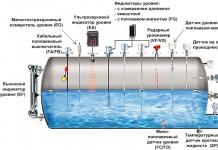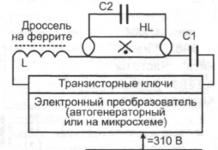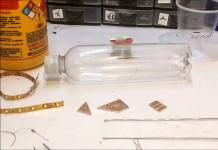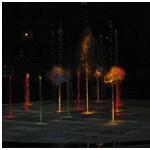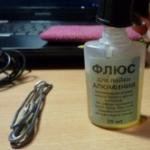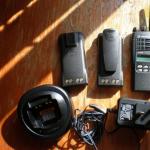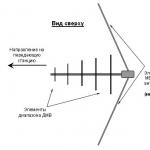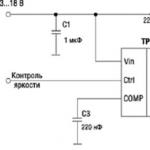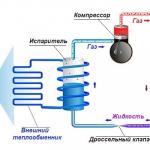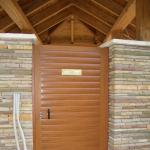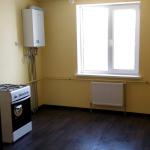However, the main problem that amateurs have when working with aluminum is it. It's just that aluminum doesn't solder. The reason for the impossibility of soldering aluminum by conventional methods is the ability to form oxide films very quickly (in fractions of a second) in air. Therefore, previously developed technologies require either special mercury fluxes or special replacement tips for soldering irons.
Most often, the need for aluminum soldering arises during the repair of resonant voltage stabilizers. In order to save money, all windings of industrial network stabilizers are made with aluminum wire. It is not necessary to solder the wires themselves. It is enough to screw a well-soldered wire to them in any way convenient for you and solder not aluminum, but this wire.
But what if it is necessary to solder not conductors, but, for example, the most inconvenient flat surfaces for soldering?
The proposed method is carried out using conventional solder and rosin with a conventional soldering iron. Since aluminum conducts heat very well, it is better to take a powerful 60-100 watt soldering iron. If your soldering iron does not have enough power to heat up large parts to be soldered, use additional parallel heating using a gas or electric stove.
Before joining, the soldering place should be thoroughly rubbed with some crumbling stone (sandstone, brick, a piece of dried mortar containing sand, etc.). The stone cleans the surface of aluminum from a thick oxide film. Sand and dust generated during the cleaning process must be left at the place of soldering. Immediately after rubbing, the aluminum surface is covered with a layer of molten rosin.
Further, the soldering technique differs little from the soldering of conventional materials, except that now the soldering iron tip must be thoroughly wiped to destroy the thin film of oxides that have formed on the cleaned surface before applying the rosin with sand.
The strength of brazed aluminum is higher than that of brazed copper. This is explained by the low melting point of aluminum (much lower than that of copper), as well as the great ability of aluminum to diffuse into other metals.
Among all aluminum soldering methods known to me, this method is the simplest, cheapest and most convenient. It is also suitable for soldering any other metals.
Magazine "ELECTRIC" (Radioamator-Electrician)
Aluminum and its alloys are only slightly inferior in strength to steel, but they are very easy to process, have a decent appearance and have such excellent qualities as thermal and electrical conductivity. However, along with these properties, there is the difficulty of their soldering. The question of how to solder aluminum is asked not only by novice amateurs, but also by those who are not difficult to solder copper, brass and steel.
Soldering aluminum is a complex process, so you need to know all its technology.
It is not easy to work with aluminum because of its ability to instantly oxidize in air, as a result of which the surface is covered with a thin film of Al2O3 oxide, which has increased resistance to aggressive environments. Therefore, special mercury fluxes or replaceable soldering tips are used, or, depending on the soldering method, the oxide is removed in various ways.
Before soldering aluminum, they resort to mechanical removal of the film, cleaning the workplace with a needle file, but the contact of aluminum with water or air leads to the initial state - the appearance of the same film.

For soldering aluminum, you can use a special flux.
Experts advise cleaning the place of soldering with a brick or sand, without removing the dust, but apply molten rosin directly on it, then rub it with a soldering iron, pressing hard with a sting. This will help break down the thin film that formed before the rosin was applied.
Also, stripped aluminum is poured with rosin and sprinkled with sawdust from an iron nail, obtained in the process of filing. Next, you need to tin the surface with a soldering iron, carefully rubbing it with a sting. Iron chips will destroy the film, while rosin will prevent the formation of a new film.
Chemical cleaning methods
It is important not to let the cleaned aluminum come into contact with air, for which the place of soldering is filled with flux or rosin, while heating it. Often small items, such as wires, are lowered directly into rosin or flux poured into a container.
In addition to the mechanical method of removing oxide, there are several so-called chemical methods.

Cleaning aluminum before soldering can be done with copper sulfate.
Purification with copper sulphate. The point where you need to make solder is cleaned with a needle file, moistened with two or three drops of copper sulfate solution. The aluminum base is connected to the negative pole of the battery or accumulator, a small piece of copper wire stripped and connected to the positive pole is lowered into the solution without touching the base. After turning on the 4.5 volt battery, a copper coating forms on aluminum after a short period of time. The desired part is then soldered to the dried copper.
Application of abrasive powder. A liquid paste is prepared by mixing the powder and transformer oil, which is applied to the cleaned surface and then rubbed with a soldering iron until a tin layer appears.
Another way is transformer. The product is connected to its minus, a copper wire containing several cores is connected to the plus. After the circuit is closed, micro-welding of aluminum with copper will occur. Soldering acid is used to speed up the process.
Back to index
Application of fluxes and solders

For soldering large parts, such as cooling radiators, soldering irons with high power (100-200 W) are used, soldering irons with a power of 60-100 W quite successfully cope with small elements. Of course, the place of solder does not have a special fortress, but this is not required.
At home, fluxes F-64, FTBf-A, FIM are suitable for soldering aluminum. Of course, you can use as a flux and aspirin, and technical vaseline, and grease, and soldering fat, and stearin.
Using special active fluxes, soldering is easier, they cope well with an oxide film, provided that the heating temperature is 250-360 ° C.
The solder is distributed over the entire surface of the connection, which leads to a strong connection of the parts. The flux must be removed using solvents, alcohol or a special liquid. The convenience of using such fluxes is that they are also used for soldering nickel, copper and steel.
As a rule, alloys used for brazing aluminum are 2 parts zinc and 8 parts tin, or 1 part copper and 99 parts tin, or 1 part bismuth and 30 parts tin. Ordinary solders POS. 40 and PIC. 60 also cope with the task.
Small holes (no more than 7 mm in diameter) in aluminum utensils can be soldered without a soldering iron. The existing enamel around the hole should be beaten off by 5 mm, lightly tapping with a hammer. Now you need to use a file or sandpaper to polish the metal to a shine, using a crumb of rosin or soldering acid, put a piece of tin into the pan on the hole and heat it over a spirit lamp, which provides spot heating without destroying the remaining enamel. The metal, melting, will completely close the hole.
So, having a desire, you can solder aluminum at home.
Soldering aluminum is a difficult process at home. The complexity is due to the properties of the metal, which make it difficult to connect individual parts of aluminum with other substances. It is necessary to connect aluminum in compliance with specially developed technologies that ensure the quality of soldering. What matters is the experience of the craftsman who joins aluminum parts by soldering.
Why aluminum doesn't solder well
Many have tried to solder aluminum at home and understood well: the solder does not want to stick to the surface of the parts. This is due to the formation of a stable oxide film on the metal, which has low adhesion to the solder material. Methods for soldering aluminum at home are reduced to the fight against a protective film.
In mineralogy, aluminum oxide is called corundum. It consists of transparent crystals, which are precious stones. Corundum has a different color, depending on impurities: chromium gives a reddish tint, sapphire - bluish. The oxide film has high strength and cannot be soldered. It must be removed from the surface and then begin to solder the parts.
How to remove oxide film
The film is removed from the metal surface in several ways, the most effective are chemical and mechanical. Both methods require an airless environment in which there is no oxygen to work.
The chemical method is based on the deposition of zinc or copper on the surface of the billet by electrolysis. Copper sulphate is applied in the form of a concentrated solution to the place prepared for soldering. The negative terminal of the battery or other power source is attached to a clean area of \u200b\u200bmetal. One end of the copper wire is connected to the positive terminal, the other is lowered into the solution on the aluminum surface. As a result of electrolysis, copper or zinc is deposited in a thin layer on aluminum and adheres strongly to it. Now you can solder aluminum with tin.
An oil film is used to remove the oxide. For this method, it is better to take synthetic or transformer oil with a low water content. Other types of oils must be kept at a temperature of + 150 ... + 200 ° C, the water will evaporate. At higher temperatures, the contents will begin to splatter. The dehydrated oil is applied to the surface of the aluminum part. With sandpaper, you need to rub aluminum under the applied layer to remove oxide.
The emery skin is replaced with a scalpel, a serrated soldering iron tip or iron shavings obtained from a nail rubbed with a file. The chips are poured onto the oil and the tip of the soldering iron is rubbed over the surface, peeling off the oxide layer. It is advisable to heat a massive part with a hot air jet. Solder with a soldering iron is immersed in an oil droplet and rubbed at the place of soldering. For a better soldering process, rosin or other flux is added.
Fluxes based on acetylsalicylic or orthophosphoric acid, salts of boric or sodium acid have been created for soldering aluminum wires. Rosin is rarely used, it is ineffective in the case of aluminum. Fluxes are used for soldering wires, pots and other things.
Fluxes for aluminum brazing
Fluxes are highly active, so after soldering they must be washed off with a solution of water and alkali. The role of alkali is well performed by baking soda. After alkali, the junction is washed with clean water. Respiratory organs should be protected from flux vapors entering them. They can irritate mucous membranes and enter the bloodstream. The most common of them need to be considered individually.
Rosin
Rosin is the most sought after of all fluxes. It is used when joining various metals. It works on aluminum only in the absence of air, so it is rarely used. More time is spent working with rosin, less efficiency. This flux is not for professionals, it can solder, but the quality of the connection is not durable.
Powder flux
Aluminum is brazed with a gas burner using powder fluxes. It is not recommended to add oxygen to the flame, it reduces the efficiency of the flux. The most common fluxes:
- F-34A;
- borax;
- acetylsalicylic acid;
- solder fat.

F-34A is an active flux containing 50% potassium chloride, 32% lithium chloride, 10% sodium fluoride and 8% zinc chloride. The composition is used with solders containing chemical additives. It is hygroscopic and dissolves in water.
Borax is a powder that melts at 700°C, is soluble in water, and is washed off with an aqueous solution of citric acid. Differs in low cost.
Acetylsalicylic acid is found in the form of aspirin tablets. When heated with a soldering iron, vapors harmful to human health are released that burn the nose, eyes and respiratory organs.
Solder fat consists of paraffin, ammonium chloride and zinc, deionized water. Good soldering of pre-heated places that have undergone a tinning procedure. After soldering aluminum parts, it is recommended to wash off the flux residues, otherwise it causes corrosion of the metal.
Liquid flux
Liquid flux is applied to the place of soldering in a thin layer. When working with a soldering iron, it quickly evaporates with the release of burning fumes. Flux F-64 contains fluorides, tetraethylammonium, corrosion inhibitors and ionized water. It destroys the oxide film well and helps to solder large aluminum workpieces. It is used when soldering copper, aluminum, galvanized iron and other metals.
F-61 consists of triethanolamine, ammonium fluoroborate and zinc fluoroborate. Used for tinning and soldering aluminum alloys at temperatures up to 250°C. Castolin Alutin 51 L consists of cadmium, lead and 32% tin. Works most effectively at temperatures above 160°C.
Any of the listed fluxes helps to solder an aluminum pan, aluminum blanks of different sizes, to connect duralumin, duralumin (duralumin) blanks by soldering.
Solder for aluminum soldering
Solder for soldering aluminum is made on the basis of zinc or aluminum. Additives are introduced into it to achieve various characteristics: to lower the melting point, increase strength. They are produced in America, Germany, France, Russia. Let's consider some of them.
Castolin 192FBK based on zinc (97%) and aluminum (2%) is produced in France. Castolin manufactures 1827 and AluFlam-190 solders for copper and aluminum brazing at 280°C.

Castolin 192FBK is a solder tube containing flux in the core. It is produced in the form of bars, 100 g of which costs 100-150 rubles. Solders small holes and cracks well.
Chemet Aluminum 13 is a solder used when welding parts at 640°C and above. It is based on aluminum (87%) and silicon (13%). The melting temperature of the solder is about 600°C. It is produced in the form of bars, of which there are 25 pieces per 100 g. 100 g cost 500 rubles. A variety called Chemet Aluminum 13-UF has a hollow structure and contains flux in the core. Its cost for 12 bars, which weigh 100 g, is 700 rubles.
Aluminum solder is also produced at domestic enterprises. For soldering with a gas burner, the composition of brand 34A is used. It melts at a temperature of 525°C, soldered alloys AMts, AM3M, AMg2 well. 100 g cost 700 rubles.
Grade A consists of 60% zinc, 36% tin and 2% copper. Melts at 425°C. Produced in rods weighing 145 g. The cost of one rod is 400 rubles.
SUPER A+ is produced in Novosibirsk and is an analogue of HTS-2000. It is applied together with gumboil of the SUPER FA brand. It costs 800 rubles. for 100 g. In the molten state it becomes viscous, it is necessary to use steel tools to level it.
Cored wire
Fluxed wire is used when welding aluminum parts, it is not suitable for soldering. Welding of aluminum with a gas torch with a flux-cored wire is not carried out. It is better to weld parts with an electric machine.
Which soldering iron is suitable
What to solder, what tool is needed for this - it all depends on the soldering area. Aluminum and copper conduct heat well, so you need a powerful soldering iron. With a part area of 1000 cm², the power of the soldering iron is 50-60 watts. Often two or more parts are soldered, in which case the power increases to 100 watts. When heating the junction, a lower power soldering iron is suitable. The sting is chosen wide, notches can be made on it to remove the aluminum oxide film.
It is required to consider how to solder aluminum with a soldering iron. This is done with a well-heated tool after removing the oxide film and tinning, the solder adheres well to the tinned (tinned using special solders) area and any soldering iron is suitable
Aluminum brazing torches
You need to know how to solder with a gas torch. If the area of \u200b\u200bthe parts is large and there is not enough soldering iron power, use a burner. It is better to use gas, because soldering aluminum with a gas burner has great potential. The burner quickly heats up the junction of parts almost to the melting temperature of aluminum. Flux with solder is applied to the connection, leveled with a soldering iron tip and hardens. The junction must be washed from the remnants of soldering acid or other flux.

When working with burners, fire safety rules must be observed. There must be no flammable liquids or materials nearby.
Which is better - welding or soldering
The answers to this question may vary. The use of one method or another depends on the use of parts after their connection. It is better to solder a car radiator. This method is cheap and reliable. Milk flasks and other food storage containers are best welded. The weld seam is more durable, especially in larger sizes. Often it is necessary to weld parts made of aluminum alloys. Silumin welding is practically the only way to connect, apart from the use of glue.
On welding and soldering, if desired, you can make good money. Questions about how to solder aluminum tubes in a refrigerator or repair a bicycle frame come up frequently. In workshops, work is expensive: soldering pipes - 1000 rubles. and more. When connecting electrical wires by soldering, they take 15 rubles. for each. Repair of a bicycle frame made of aluminum alloys using solders costs 500 rubles. Repair of the pan will cost 100 rubles. To these amounts should be added the cost of time and money for the delivery of products to the workshop and back.
To save this money, you need to learn how to solder yourself. To do this, you need to purchase a gas burner in the form of a can for 700-1000 rubles. and solder. You can learn surface treatment and suturing on an old car radiator.
There is an opinion that before soldering aluminum at home, you should stock up on special quality solder, as well as a special soldering tool (in particular, a gas burner). In this case, the following facts are given as explanations: firstly, there is always an oxide film on the aluminum surface and, secondly, its heating temperature is quite high.
And, indeed, due to the characteristic metal coating, tinning and soldering aluminum at home is associated with certain difficulties. Special solders used simultaneously with active fluxes for aluminum will help to solve this problem.
Let's consider each of the above consumables in more detail.
High temperature solder
The composition of traditional low-melting solder includes such mandatory components as tin (Sn) and lead (Pb) with small additions of bismuth (Bi), cadmium (Cd) and zinc (Zn). By means of such a soldering composition, it is possible to process copper and steel blanks, when soldering which surfaces rarely heat up above 300 degrees.
Before soldering aluminum with conventional means, you should be aware that these compositions are not suitable for processing this metal, since the working temperature of its heating must be much higher. For work in this category, special solders for aluminum will be required, which include high-temperature silicon in their composition. As additives, they contain copper and other active components (silver and or zinc components, for example).
Important! They should also include an aluminum component.

Note! With an increase in the amount of zinc, the solder for soldering aluminum acquires good resistance to corrosive destruction.
Thus, it is customary to classify high-temperature solders, which include such essential components as silicon, copper and aluminum (zinc). As an example, a well-known sample of domestic aluminum solder - 34A, as well as its imported analogue under the designation "Aluminum-13" can be considered. They usually contain up to 87% aluminum and about 13% silicon, which allows you to raise the soldering temperature to approximately 590-600 ° C.
Flux component
Flux for soldering aluminum is usually selected taking into account the chemical activity of its components in relation to this metal. For these purposes, such well-known domestic mixtures as F-64, F-59A, F-61A, which include ammonium components and other additives active in relation to aluminum, are quite suitable.
Containers with these soldering reagents usually have labels with special marks "for aluminum soldering".
To work with this metal, a flux produced under the brand name "34A" can be used, which includes chloride compounds of potassium, zinc and lithium in the required proportion, as well as sodium fluoride (10%). These mixtures are considered the most suitable when brazing aluminum with copper or other non-ferrous metals is expected.

The procedure for carrying out soldering work
Surface preparation
Soldering aluminum with tin with active additives begins with the preparation of the surfaces of the articulating parts or products. To do this, you need to do the following operations on them:
- Thoroughly degrease them using a soft flannel soaked in acetone;
Additional Information. Instead of acetone, any traditional solvent replacing it (gasoline, for example) can be used.
- Clean the place to be soldered, for which it is recommended to use fine-grained emery cloth;
- As a fallback, surface etching with special active compounds can be proposed, however, due to its specificity, this procedure is used extremely rarely.
It should be remembered that it is not possible to completely remove the oxide film in one go, since a new thin layer immediately forms in this area. Surface cleaning is carried out not to completely remove the unwanted coating, but to partially neutralize it before fluxing. Upon completion of this operation, the surface can be soldered quite easily.
Soldering zone heating
In order to solder small-sized aluminum blanks, a low-power soldering iron (no more than 100 watts) is enough. For soldering massive products or parts, you will need to use a higher power soldering iron. A special powerful tool or a gas burner is best suited for these purposes.

Soldering aluminum with a gas burner (sometimes a blowtorch is used for these purposes) has a special specificity, manifested in the following features:
- First, it is not recommended to strongly overheat aluminum, as it may partially melt. To prevent this effect during soldering, periodically touch the solder to the surface to be treated. Its melting will mean that the required temperature has already been reached;
- Secondly, it is undesirable to use oxygen as an enricher of the gas mixture, since it can provoke the oxidation of the metal.

Soldering instructions
In order to obtain a solder joint of aluminum products, one should be guided by a standard technique, which involves the following procedure :
- First, the surface at the place of soldering is degreased, after which this area is thoroughly cleaned;
- If you need to solder one part to another, both of them are securely fixed in a vice or clamp;
- After that, it will be possible to start warming up the joints;
- In the process of soldering with a special solder on aluminum containing an activator, they touch the joint several times. When using conventional solder, a special flux is required to actively influence the oxide film.
Note! For reliable destruction of the surface film of aluminum oxide, it is recommended to use a brush with steel wire bristles. By means of this simplest tool, during the soldering process, it is possible to evenly distribute all the solder over the plane of the processed aluminum blanks.
What to do if the required materials are not available
In a situation where the household does not have the consumables necessary for soldering, you can use traditional solders. In this case, the flux is replaced by ordinary alcohol rosin, with which the aluminum surface is poured after its preliminary cleaning. This provides protection against oxidation and the formation of an undesirable oxide film.
With this approach, the soldering iron is simultaneously used as a tool that destroys this obstacle. For this purpose, a special scraper is installed on the tip of the soldering device, through which it is possible to constantly clean off the resulting oxide layer. In addition, it is possible to increase the productivity of such a process if a little sawdust is added to the rosin, which is formed during metal cutting.
Solder the parts in this case as follows:
- First, a well-heated soldering iron with a pre-tinned tip melts a small amount of rosin at the soldering point;
- After it completely covers the entire heated area, it should be rubbed with a soldering iron tip with an effort on its surface. A small amount of metal filings must be added to the place of soldering, which, together with the sting, effectively destroy the oxide film;
- Upon completion of the tinning procedure, the processed aluminum blanks are interconnected and thoroughly heated with an ordinary soldering iron.
In the final part of the review, we note that soldering without the use of special equipment and active consumables is a very time-consuming and troublesome procedure that does not guarantee a positive result. It is for this reason that only well-trained users with extensive experience with soldering equipment can resort to this soldering method.
In the event that there is no absolute self-confidence, it is best to purchase all the necessary materials and try to rent the required tool (gas burner in particular).
Video
Industrial production of aluminum, by historical standards, began relatively recently. But during this time, this material has firmly entered our lives. Its main parameters - high electrical and thermal conductivity, low weight, resistance to corrosion have led to the fact that this metal has become the main material used in the aviation and space industries. In addition, it is impossible to imagine the streets of our cities without aluminum, translucent structures (doors, windows, stained-glass windows), advertising structures and much more are made from it.
When processing it, it is permissible to use almost all types of processing - turning, stamping, casting, welding and soldering. The latter methods are used to obtain permanent joints from aluminum blanks.
General principles for soldering aluminum at home
Many sincerely believe that soldering aluminum at home is a rather complicated process. But in fact, everything is not so bad. If you use the appropriate solders and fluxes, then there should not be any particular difficulties. In the event that a home artisan will solder aluminum parts using materials intended for copper or steel, then the result will most likely be negative.
Process Features
The difficulties of soldering aluminum are primarily due to the fact that there is an oxide film on its surface, which, unlike the base metal, has a higher melting point and high resistance to various chemicals. It is this film that creates serious obstacles when using traditional solders and fluxes, and for example, if aluminum is soldered with tin, it is difficult to guarantee a high-quality result. To eliminate this film, either mechanical action or fluxes are used, which contain potent chemicals.
The base metal itself, in this case aluminum, has a low melting point of about 660 °C. Such a difference between the melting temperature of the oxide film and the base metal also leads to complications in soldering.
This property of aluminum results in heated aluminum becoming less durable. Thus, aluminum structures begin to lose stability already at a temperature of 250-300 °C. In addition, the composition of aluminum alloys may include materials that begin to melt at a temperature of 500-650 ° C.
The composition of a large number of solders includes - tin, cadmium and other components. Aluminum is difficult to come into contact with these materials and this in turn leads to the fact that the seams obtained using these solders are of low reliability and strength. Meanwhile, zinc and aluminum have good solubility in each other. The use of zinc in the composition of solders allows you to give the seam high strength parameters.
Use of transformer oil
As noted above, the main obstacle to soldering is the presence of an oxide film. Before soldering aluminum, it must be eliminated. Various methods are used to remove it, ranging from the use of an abrasive tool to special fluxes. In addition, there are "folk" ways. One of them is related to the use of transformer oil.
To remove the oxide film, the following composition is used - transformer oil is added to the abrasive powder. With constant stirring, the result should be a pasty mass. It must be applied to a pre-cleaned soldering area. After that, the soldering iron tip must be thoroughly tinned and the prepared places are rubbed until tin appears. After this, the soldering points must be washed and you can continue to work.
What solder is used for soldering aluminum
Most solders contain substances that do not dissolve in aluminum. That is why the so-called refractory solders made on the basis of aluminum, cadmium, zinc and some other substances are used to create permanent connections of aluminum parts.
Low-melting solders are also used for soldering aluminum.
Their use allows you to work at low temperatures. This allows you to create connections, while avoiding changes in the properties of aluminum. But it should be noted right away that the use of such materials cannot provide adequate corrosion resistance and joint strength.
The best soldering result can be obtained when using a composition that contains aluminum, copper, zinc. Work with such solders must be carried out with a soldering iron, the tip of which is heated to 350 ° C. When connecting parts, you need to use a flux, which consists of a mixture of oleic acid and lithium iodide.
The composition for joining aluminum parts can be prepared at home, or you can simply purchase it at the store.
One of the mass-produced solders for aluminum is HTS-2000. Soldering with this solder can be done without the use of flux. A distinctive feature of this composition is that it can penetrate the oxide film and can create strong molecular bonds. The service life of joints made using this alloy is 10 years.
How to solder with a torch
The need for soldering aluminum and its alloys can arise both in industrial and domestic conditions. This process can be used when repairing parts, but sometimes you have to deal with more extensive work.
Machining aluminum involves a number of difficulties and therefore traditional soldering materials do not always guarantee a proper result.
One of the commonly used methods for obtaining permanent joints is directly related to the use of a gas burner.
Working with aluminum means that the oxide film that is on the surface of the part prevents the parts from joining.
Soldering with a torch is significantly different from working with a soldering iron and is rightfully considered more practical. While working with the burner, the master can adjust the temperature. And this provides additional opportunities for surface treatment of workpieces. In this case, the thickness of the material does not play a special role. Sometimes when working with a burner, fluxes and additional surface treatments are used.
Soldering aluminum with a gas torch in a home workshop allows you to preheat workpieces and consumables.
Undoubtedly, experience is necessary to obtain a high quality connection. The fact is that aluminum has a low melting point, so consumables used in soldering have good fluidity. If the master makes a mistake, then there is a high probability that the solder will simply spread over the workpiece without hitting the seam.
What flux to use
Advantages
Soldering is one of the ways to obtain permanent metal joints. But unlike other methods, until recently, it was distinguished by low productivity, low strength at the junction. This and a number of other reasons served to the fact that it did not receive wide, industrial application.
With the development of technology, methods have become available for connecting parts using an electron beam, ultrasonic waves. The advent of special solders and fluxes made it possible to significantly improve the quality of the solder joint.
Modern soldering technologies allow the use of finished products without further processing on mechanical equipment. Soldering has become one of the main technological processes in mechanical engineering, aviation and space industries and, of course, electronics.
Soldering has a number of undoubted advantages in comparison with welding. The process of joining parts in this way takes place at a significantly lower heat consumption. In other words, during this process there are no major changes in the structure of the metal. Its physical and chemical parameters remain practically unchanged. After soldering, phenomena such as permanent deformation can occur, its dimensions are incomparable with those that remain after, for example, welding in a shielding gas cloud.
That is why the use of soldering guarantees more accurate compliance with the dimensions specified in the technical documentation for the product. Using this method allows you to connect dissimilar metals. In addition, we can say that these processes can be automated quite easily.
Flaws
Speaking about the soldering of aluminum parts, one must always remember that to work with it, it is necessary to use special solders and fluxes, which are able to meet the requirements for the quality of the joints obtained.
The slightest violation of technology or the use of unsuitable materials will lead to the fact that the resulting seam will not meet the quality requirements.
